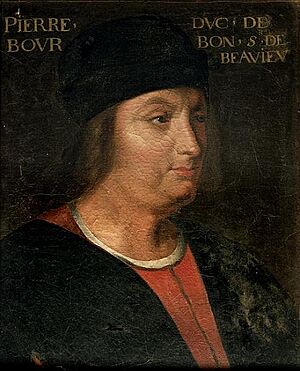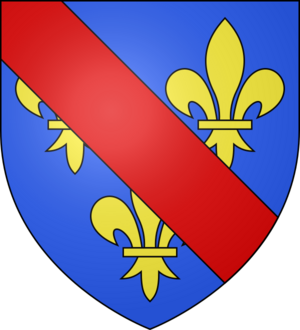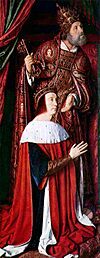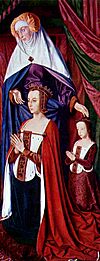Peter II, Duke of Bourbon facts for kids
Quick facts for kids Peter II |
|
|---|---|
| Duke of Bourbon | |
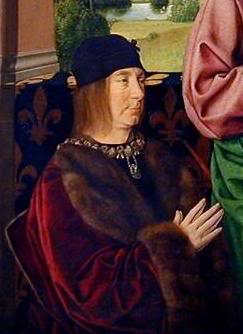
|
|
| Regent of France | |
| Regency | 1483–1491 |
| Monarch | Charles VIII |
| Co-Regent | Anne of France |
| Born | 1 December 1438 Moulins |
| Died | 10 October 1503 (aged 64) |
| Spouse | |
| Issue | Charles, Count of Clermont Suzanne, Duchess of Bourbon |
| House | Bourbon |
| Father | Charles I, Duke of Bourbon |
| Mother | Agnes of Burgundy |
Peter II, Duke of Bourbon (born December 1, 1438 – died October 10, 1503 in Moulins) was an important French nobleman. He was the son of Charles I, Duke of Bourbon and Agnes of Burgundy. Peter was a member of the powerful House of Bourbon family. He and his wife, Anne of France, ruled France as regents when King Charles VIII of France was too young to rule by himself.
Life and Marriage
Peter was a very loyal and skilled helper to the King of France. He earned the respect of King Louis XI by showing that his family, the Bourbons, were humble and obedient.
At first, Peter was supposed to marry Marie d'Orleans. She was the sister of Louis, Duke of Orleans, who later became King Louis XII. But King Louis XI did not want two powerful families like the Bourbons and the Orleans to become too close. So, he stopped Peter's engagement to Marie.
Instead, King Louis XI arranged for Peter to marry his own older daughter, Anne of France. This marriage helped to connect the Bourbon family more closely to the royal family. As a special gift, the King made Peter's older brother, John II, Duke of Bourbon, give the land of Beaujeu to Peter. Peter also got a place on the King's special council of advisors. Peter and Anne were married on November 3, 1473.
Regent of France and Duke of Bourbon
When King Louis XI died in 1483, Peter was one of the few people who had always stayed in the King's good graces. On his deathbed, King Louis XI chose Peter to be the guardian of the new young king, Charles VIII of France. Peter and his wife Anne quickly took on their new roles. They began to lead the government that would rule while the King was still a child.
The young King Charles VIII was crowned soon after, which meant the official need for a regency government ended. However, the thirteen-year-old king was still very young. Peter and Anne continued to guide him in ruling the kingdom.
By 1488, Peter and Anne were building their own strong base of power in the Bourbonnais region. Anne was already the Countess of Gien. Peter was the Count of Clermont and La Marche, and the Lord of Beaujeu. Then, his oldest brother, John II, died. His next oldest brother, Charles II, gave up his family rights. This meant that Peter inherited the main Bourbon lands and titles. These included the Duchies of Bourbon and Auvergne, and the Counties of Forez and l'Isle-en-Jordain.
The new Duke and Duchess of Bourbon then added even more lands to their control. They gained Bourbon-Lancy in December 1488. They also traded l'Isle-en-Jordain for Murat and the viscounty of Carlat in June 1489. The King gave them these lands as their absolute right. This meant the lands would not return to the crown, and they did not have to pass to the next family heirs. Peter and Anne could give these lands to anyone they wanted.
On May 10, 1491, Peter and Anne finally had a child of their own, a daughter named Suzanne. Anne had been pregnant before in 1476, but there are different stories about what happened. Some say the baby was lost, while others say a son was born who died young. Suzanne became their main heir.
By 1491, the Bourbon family's influence over the King was becoming weaker. Charles VIII was now an adult and did not want his family telling him what to do. Against Anne and Peter's advice, Charles chose to end his marriage to Margaret of Austria. Instead, he married Anne, Duchess of Brittany. He also went against their wishes by giving back Margaret's dowry (the lands of Artois and Franche-Comté) to her brother.
Peter and Anne could not stop Charles from going on his expensive trips to Italy. However, they were left in charge of France several times when he was away. They continued to be important people at court for the rest of Charles VIII's reign, but with less power. After Charles VIII died and Louis XII became king, Peter mostly retired from court life. He spent his last years with his family, especially his daughter Suzanne.
Succession to the Duchy of Bourbon
Since Peter did not have any sons who lived, his daughter Suzanne was the next in line to inherit the Bourbon Duchy. In his final years, Peter and Anne disagreed about Suzanne's future and the Bourbon lands. With King Charles VIII dead and the more careful King Louis XII on the throne, Suzanne needed a husband to help her keep her inheritance. This was because the crown and another branch of the family, the Montpensiers, might try to claim the lands.
The Duke and Duchess first thought about having Suzanne marry Louis of Bourbon-Montpensier. He was the next male heir in the Bourbon family. But Louis offended Peter badly by speaking against a royal document from King Louis XII. This document had confirmed Suzanne's right to inherit the lands.
So, Peter decided to arrange for Suzanne to marry Charles IV, Duke of Alençon. Charles was a favorite of King Louis XII. Peter hoped this marriage would protect the duchy from the King and from the Montpensier family. This marriage contract was signed on March 21, 1501, in Moulins. Charles was 11 years old, and Suzanne was 9.
However, Peter died of a fever before this marriage could happen. After his death, Anne arranged for Suzanne to marry Charles of Bourbon-Montpensier. Louis of Bourbon-Montpensier had died the year before. This marriage prevented a fight over the Bourbon inheritance, which the young couple then inherited together.


